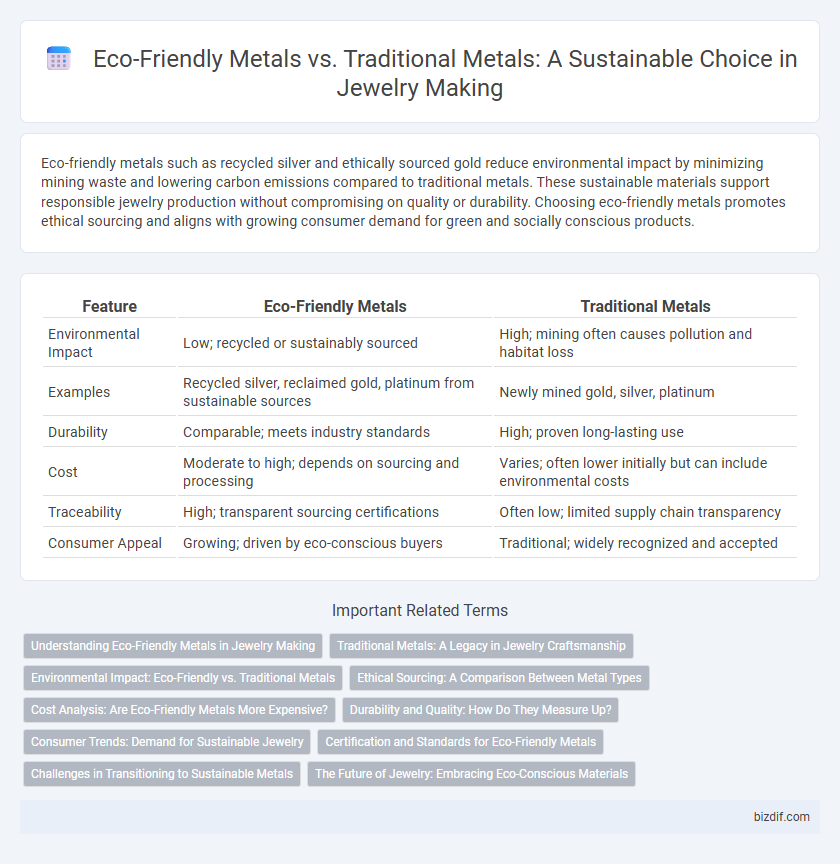Eco-friendly metals such as recycled silver and ethically sourced gold reduce environmental impact by minimizing mining waste and lowering carbon emissions compared to traditional metals. These sustainable materials support responsible jewelry production without compromising on quality or durability. Choosing eco-friendly metals promotes ethical sourcing and aligns with growing consumer demand for green and socially conscious products.
Table of Comparison
| Feature | Eco-Friendly Metals | Traditional Metals |
|---|---|---|
| Environmental Impact | Low; recycled or sustainably sourced | High; mining often causes pollution and habitat loss |
| Examples | Recycled silver, reclaimed gold, platinum from sustainable sources | Newly mined gold, silver, platinum |
| Durability | Comparable; meets industry standards | High; proven long-lasting use |
| Cost | Moderate to high; depends on sourcing and processing | Varies; often lower initially but can include environmental costs |
| Traceability | High; transparent sourcing certifications | Often low; limited supply chain transparency |
| Consumer Appeal | Growing; driven by eco-conscious buyers | Traditional; widely recognized and accepted |
Understanding Eco-Friendly Metals in Jewelry Making
Eco-friendly metals in jewelry making, such as recycled silver, reclaimed gold, and sustainably sourced palladium, significantly reduce environmental impact by minimizing mining waste and conserving natural resources. These metals often undergo processes that lower carbon emissions and eliminate harmful chemicals compared to traditional metals like newly mined gold, silver, and platinum. Using eco-friendly metals promotes ethical sourcing and supports circular economy principles, making them a preferred choice for sustainable and responsible jewelry production.
Traditional Metals: A Legacy in Jewelry Craftsmanship
Traditional metals such as gold, silver, and platinum have long been prized in jewelry making for their durability, luster, and timeless appeal. These metals offer exceptional malleability and strength, supporting intricate designs and enduring wear over generations. Despite environmental concerns, their well-established supply chains and consistent quality keep traditional metals at the forefront of heritage jewelry craftsmanship.
Environmental Impact: Eco-Friendly vs. Traditional Metals
Eco-friendly metals such as recycled silver, ethical gold, and reclaimed platinum significantly reduce environmental degradation by minimizing mining activities and lowering carbon emissions. Traditional metals often involve extensive mining processes that cause deforestation, soil erosion, and water contamination, resulting in a larger ecological footprint. Choosing eco-friendly metals in jewelry making supports sustainable practices and helps preserve natural ecosystems while maintaining high-quality craftsmanship.
Ethical Sourcing: A Comparison Between Metal Types
Eco-friendly metals such as recycled silver and ethically sourced platinum prioritize reducing environmental impact and ensuring fair labor practices, contrasting with traditional metals like conventional gold and silver often linked to mining practices with significant ecological damage and exploitative labor conditions. Ethical sourcing in eco-friendly metals includes certifications like Fairmined and Fairtrade Gold, which guarantee traceability and responsible mining standards, whereas traditional metals frequently lack transparent supply chains. Choosing eco-friendly metals supports sustainable jewelry making by minimizing harmful mining effects and promoting social responsibility within the metal sourcing industry.
Cost Analysis: Are Eco-Friendly Metals More Expensive?
Eco-friendly metals such as recycled gold, recycled silver, and fair-mined platinum often come at a higher price point compared to traditional metals due to sustainable sourcing and ethical production processes. The cost of eco-friendly metals is influenced by the demand for responsible mining, supply chain transparency, and certifications like Fairmined or Fairtrade. While initial expenses may be higher, using eco-friendly metals can offer long-term value through brand differentiation and appeal to environmentally conscious consumers in the jewelry market.
Durability and Quality: How Do They Measure Up?
Eco-friendly metals like recycled silver and platinum offer comparable durability and quality to traditional metals, often matching their resistance to tarnish and wear. These sustainable materials maintain the same hardness and luster, ensuring longevity in fine jewelry pieces. Advances in refining techniques have enhanced the purity and strength of eco-friendly metals, making them a viable alternative without compromising on craftsmanship.
Consumer Trends: Demand for Sustainable Jewelry
Growing consumer demand for sustainable jewelry drives the adoption of eco-friendly metals such as recycled gold, recycled silver, and ethically sourced platinum. These metals reduce environmental impact by minimizing mining activities and lowering carbon footprints compared to traditional metals. Jewelers increasingly highlight transparency, traceability, and certification to meet the preferences of environmentally conscious buyers seeking responsibly crafted pieces.
Certification and Standards for Eco-Friendly Metals
Certification and standards for eco-friendly metals in jewelry making, such as the Responsible Jewellery Council (RJC) certification, ensure sustainable sourcing and ethical practices throughout the supply chain. Eco-friendly metals like recycled gold and reclaimed silver often comply with stringent environmental regulations and transparency requirements, promoting reduced ecological impact compared to traditional mined metals. These certifications validate that the metals meet international standards for responsible mining, environmental stewardship, and social responsibility, providing consumers with verified sustainable options.
Challenges in Transitioning to Sustainable Metals
Transitioning to sustainable metals in jewelry making faces challenges such as higher costs and limited availability of eco-friendly metals like recycled silver and ethically sourced gold. Traditional metals, often mined through environmentally damaging practices, remain more accessible, creating supply chain complexities for jewelers. Ensuring consistent quality and certification of sustainable metals also requires rigorous oversight and investment.
The Future of Jewelry: Embracing Eco-Conscious Materials
Eco-friendly metals like recycled gold and lab-grown silver significantly reduce environmental impact compared to traditional mining methods, meeting increasing consumer demand for sustainable jewelry. Innovations in sustainable metal sourcing and refining processes contribute to lower carbon footprints and ethical production standards within the jewelry industry. As eco-conscious materials gain traction, the future of jewelry emphasizes transparency, durability, and environmental responsibility without sacrificing aesthetic quality.
Eco-friendly metals vs Traditional metals Infographic

 bizdif.com
bizdif.com